Oldsmobile Bravada 2003 s Owners Manual
Manufacturer: OLDSMOBILE, Model Year: 2003, Model line: Bravada, Model: Oldsmobile Bravada 2003Pages: 410, PDF Size: 20.1 MB
Page 91 of 410

2. Move the shift lever
into PARK (P) like this:
Press and hold in the button on the lever.
Push the lever all the way toward the front of the
vehicle.
3. Turn the ignition key to LOCK.
4. Remove the key and take it with you. If you can
leave your vehicle with the key, your vehicle is in
PARK
(P).
Leaving Your Vehicle With the Engine
Running
It can be dangerous ,I leave your vehicle --ith
the engine running. Your vehicle could move
suddenly
if the shift lever is not fully in
PARK (P) with the parking brake firmly set.
And,
if you leave the vehicle with the engine
running,
it could overheat and even catch fire.
You or others could be injured. Don’t leave
, your vehicle with the engine running.
If you have to leave your vehicle with the engine
running, be sure your vehicle is in PARK (P) and your
parking brake is firmly set before you leave it. After
you’ve moved the shift lever into PARK (P), hold
the regular brake pedal down. Then, see
if you can
move the shift lever away from PARK (P) without first
pressing the button on the console shift lever. If you can,
it means that the shift lever wasn’t fully locked into
PARK (P).
2-26
Page 92 of 410
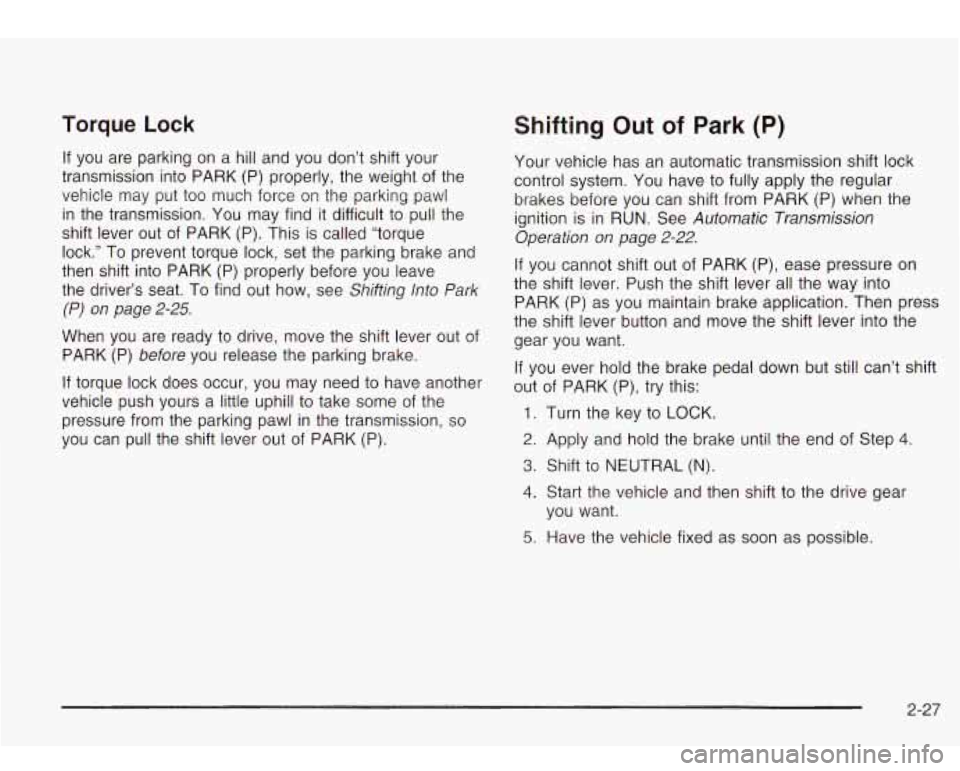
Torque Lock
If you are parking on a hill and you don’t shift your
transmission into PARK (P) properly, the weight of the
vehicle may put too much force on the parking pawl
in the transmission. You may find it difficult to pull the
shift lever out of PARK (P). This is called “torque
lock.” To prevent torque lock, set the parking brake and
then shift into PARK
(P) properly before you leave
the driver’s seat. To find out how, see
Shifting Into Park
(P) on page 2-25.
When you are ready to drive, move the shift lever out of
PARK (P)
before you release the parking brake.
If torque lock does occur, you may need to have another
vehicle push yours a little uphill to take some of the
pressure from the parking pawl in the transmission,
so
you can pull the shift lever out of PARK (P).
Shifting Out of Park (P)
Your vehicle has an automatic transmission shift lock
control system. You have to fully apply the regular
brakes before you can shift from PARK (P) when the
ignition is in RUN. See
Automatic Transmission
Operation
on page 2-22.
If you cannot shift out of PARK (P), ease pressure on
the shift lever. Push the shift lever all the way into
PARK (P) as you maintain brake application. Then press
the shift lever button and move the shift lever into the
gear you want.
If you ever hold the brake pedal down but still can’t shift
out of PARK (P), try this:
1. Turn the key to LOCK.
2. Apply and hold the brake until the end of Step 4.
3. Shift to NEUTRAL (N).
4. Start the vehicle and then shift to the drive gear
you want.
5. Have the vehicle fixed as soon as possible.
2-27
Page 93 of 410

Parking Over Things That Burn Engine Exhaust
Things &..At can burn
cc,.d touch hot exhaust
parts under your vehicle and ignite. Don’t park
over papers, leaves, dry grass or other things
that can burn. Engine exhaust can ki
It c tains the gas
carbon monoxide
(CO), which you can’t see or
smell.
It can cause unconsciousness and
death.
You might have exhaust coming in
if:
Your exhaust system sounds strange or
Your vehicle gets rusty underneath.
Your vehicle was damaged in a collision.
Your vehicle was damaged when driving over high points on the road or over road
debris.
different.
Repairs weren’t done correctly.
Your vehicle or exhaust system had been
modified improperly.
If you ever suspect exhaust is coming into
your vehicle:
Drive it only with all the windows down to
Have your vehicle fixed immediately.
blow out any
CO; and
2-28
Page 94 of 410
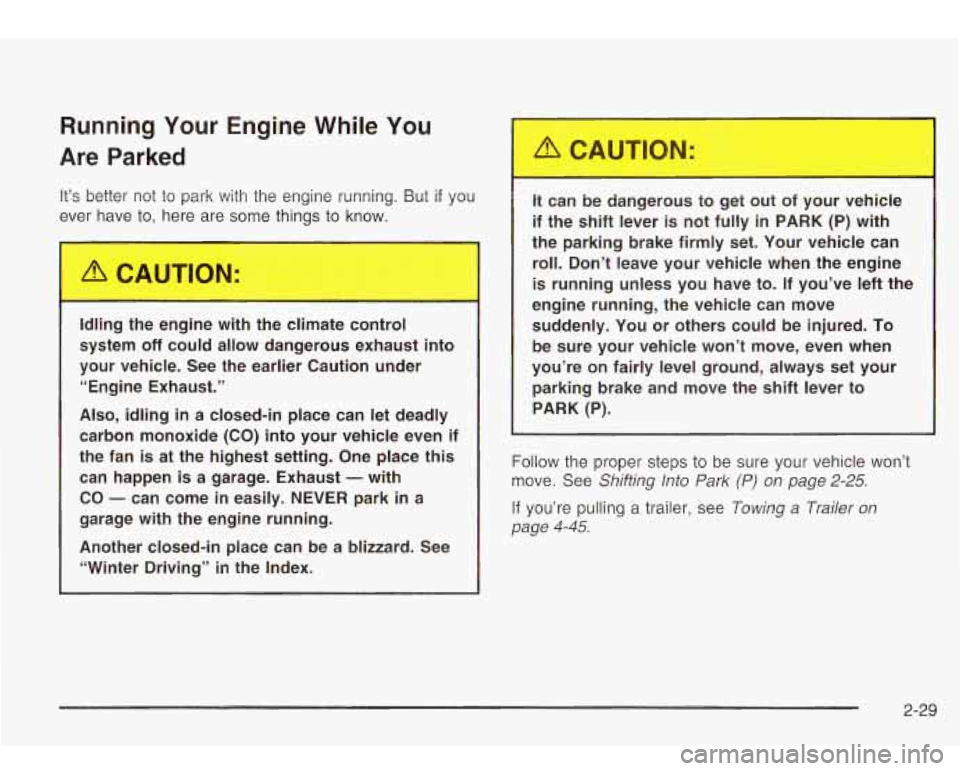
Running Your Engine While You
Are Parked
It’s better not to park with the engine running. But if you
eve- to, here are some
things to know.
Idling the engine with the climate control
system
off could allow dangerous exhaust into
your vehicle. See the earlier Caution under
“Engine Exhaust.”
Also, idling in a closed-in place can let deadly
carbon monoxide (CO) into your vehicle even if
the fan
is at the highest setting. One place this
can happen is a garage. Exhaust - with
CO - can come in easily. NEVER park in a
garage with the engine running.
Another closed-in place can be a blizzard. See
“Winter Driving” in the Index.
It can be dangerous to get out of your vehicle
if the shift lever is not fully in
PARK (P) with
the parking brake firmly set. Your vehicle can
roll. Don’t leave your vehicle when the engine
is running unless you have to. If you’ve left the
engine running, the vehicle can move
suddenly. You or others could be injured.
To
be sure your vehicle won’t move, even when
you’re on fairly level ground, always set your parking brake and move the shift lever to
PARK (P).
Follow the proper steps to be sure your vehicle won’t
move. See
Shifting Into Park (P) on page 2-25.
If you’re pulling a trailer, see Towing a Trailer on
page
4-45.
2-29
Page 95 of 410
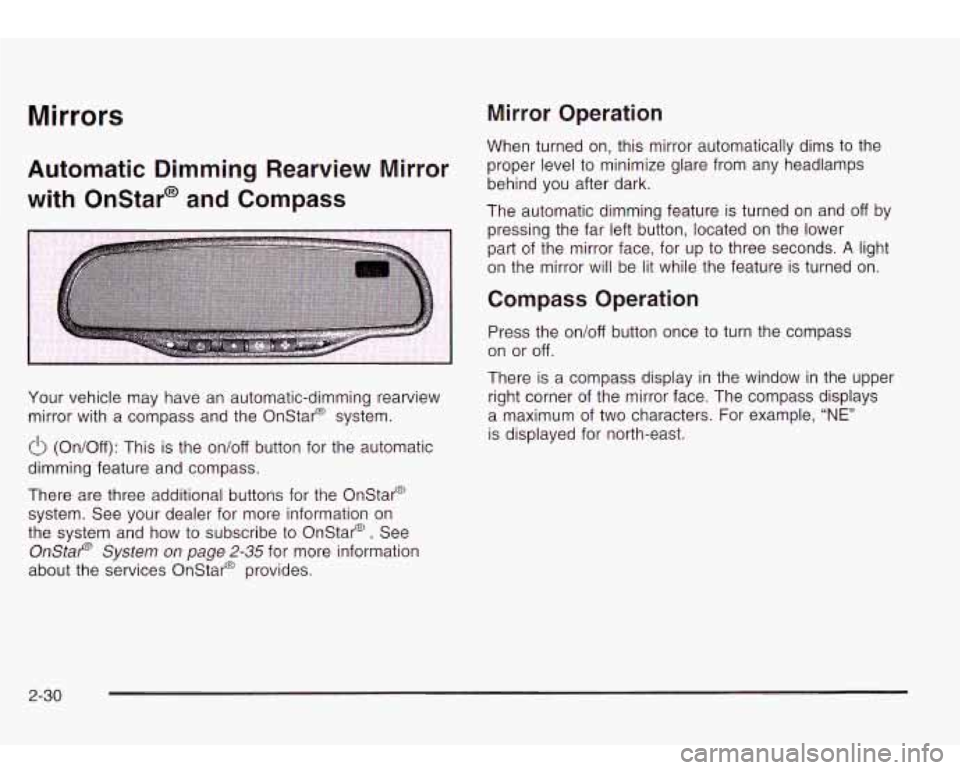
Mirrors Mirror Operation
Automatic Dimming Rearview Mirror
with Onstar@ and Compass
Your vehicle may have an automatic-dimming rearview
mirror with a compass and the Onstar@ system.
(!J (On/Off): This is the on/off button for the automatic
dimming feature and compass.
There are three additional buttons for the Onstar@
system. See your dealer for more information on
the system and how to subscribe to Onstar@. See
Onstar@ System on page 2-35 for more information
about the services Onstar@ provides. When
turned on, this mirror automatically dims to the
proper level to minimize glare from any headlamps
behind you after dark.
The automatic dimming feature is turned on and off by
pressing the far left button, located on the lower
part of the mirror face, for up to three seconds.
A light
on the mirror will be lit while the feature
is turned on.
Compass Operation
Press the on/off button once to turn the compass
on or off.
There is a compass display in the window in the upper
right corner of the mirror face. The compass displays
a maximum of two characters. For example,
“NE”
is displayed for north-east.
2-30
Page 96 of 410
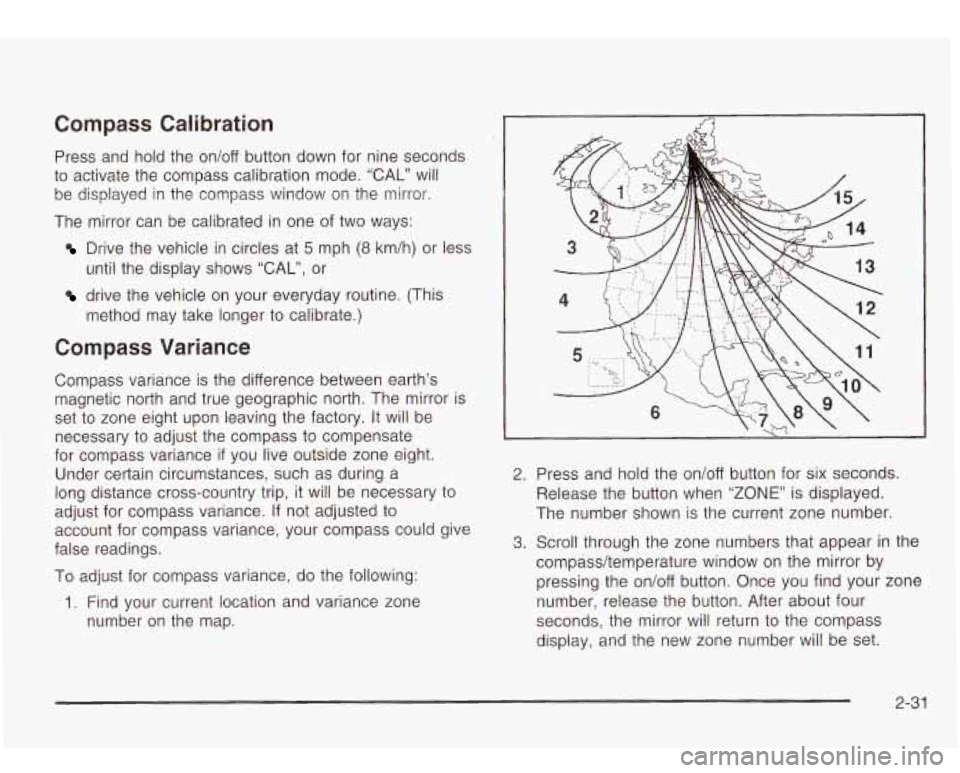
Compass Calibration
Press and hold the on/off button down for nine seconds
to activate the compass calibration mode. “CAL” will
be displayed in the compass window on the mirror.
The mirror can be calibrated in one of two ways:
Drive the vehicle in circles at 5 mph (8 km/h) or less
drive the vehicle on your everyday routine. (This
until
the display shows “CAL”, or
method may take longer
to calibrate.)
Compass Variance
Compass variance is the difference between earth’s
magnetic north and true geographic north. The mirror is
set
to zone eight upon leaving the factory. It will be
necessary
to adjust the compass to compensate
for compass variance
if you live outside zone eight.
Under certain circumstances, such as during a
long distance cross-country trip, it will be necessary
to
adjust for compass variance. If not adjusted to
account for compass variance, your compass could give
false readings.
To adjust for compass variance, do the following:
1. Find your current location and variance zone
number on the map.
2. Press and hold the on/off button for six seconds.
Release the button when
“ZONE” is displayed.
The number shown is the current zone number.
3. Scroll through the zone numbers that appear in the
compass/temperature window on the mirror by
pressing the
on/off button. Once you find your zone
number, release the button. After about four
seconds, the mirror will return to the compass
display, and the new zone number will be set.
2-31
Page 97 of 410

Outside Manual Mirrors
Adjust your outside mirrors so you can see a little of the
side
of your vehicle.
Fold the mirrors in before entering a car wash. To do
this,
pull the mirrors in toward the vehicle. Push the
mirrors back out when finished.
Outside Power Mirror
The control is located on the driver’s door.
1. Twist the knob toward the mirror you desire to
2. Move the control in the direction you want the
3. Adjust the mirror in all four directions.
adjust.
mirror to
go.
4. After you are satisfied with the position of the
mirror, twist the control
to the center position or twist
it
to the other mirror to adjust that mirror.
If you reach the mirror’s end of the travel position in any
direction, the mirror will enter a ratcheting mode. This
action is harmless.
It is a warning that the mirror can go
no further. To stop this action, back the mirror up by
moving the control in the opposite direction.
When the control is twisted
to the center position, the
mirrors can not be moved with the control knob.
2-32
Page 98 of 410
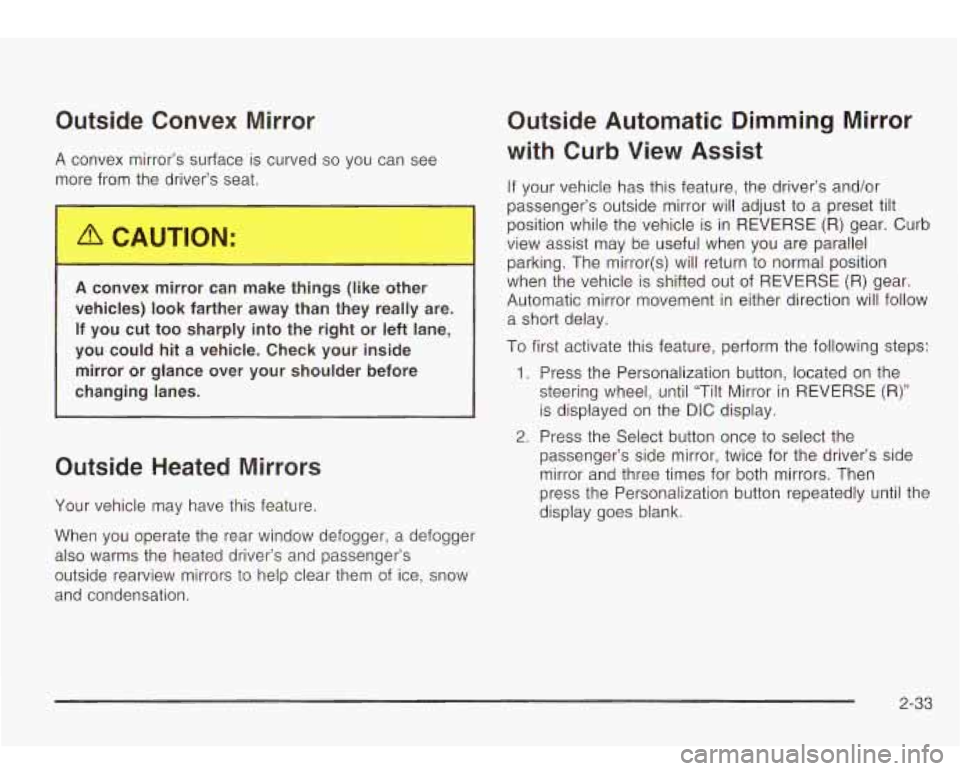
Outside Convex Mirror
A convex mirror’s surface is curved so you can see
more from the driver’s seat.
A convex mirror can make things (like other
vehicles) look farther away than they really are.
If you cut too sharply into the right or left lane,
you could hit a vehicle. Check your inside
mirror or glance over your shoulder before
changing lanes.
Outside Heated Mirrors
Your vehicle may have this feature,
When you operate the rear window defogger, a defogger
also warms the heated driver’s and passenger’s
outside rearview mirrors to help clear them of ice, snow
and condensation.
Outside Automatic Dimming Mirror
with Curb View Assist
If your vehicle has this feature, the driver’s and/or
Passenger’s outside mirror will adjust to a preset tilt
losition while the vehicle is in REVERSE
(R) gear. Curb
view assist may be useful when you are parallel
parking. The mirror(s) will return
to normal position
when the vehicle is shifted out of REVERSE
(R) gear.
Automatic mirror movement in either direction will follow
a short delay.
To first activate this feature, perform the following steps:
1. Press the Personalization button, located on the
steering wheel, until “Tilt Mirror in REVERSE
(R)”
is displayed on the DIC display.
passenger’s side mirror, twice for the driver’s side
mirror and three times for both mirrors. Then
press the Personalization button repeatedly until the
display goes blank.
2. Press the Select button once to select the
2-33
Page 99 of 410

3. With the engine running, engage the parking brake,
press the brake pedal and place the vehicle in
REVERSE
(R) gear. When
the vehicle is placed in PARK
(P) or in any
forward gear, the mirror(s) will return
to normal
driving position, following a short delay.
4. Adjust the passenger’s side and then the driver’s To change the tilt position, adjust the mirror while the
side outside mirrors
to the desired tilt positions. vehicle is in REVERSE (R) gear with the engine running,
These positions will be stored into memory once the
the parking brake engaged and the brake pedal
vehicle is shifted
out of REVERSE (R). pressed. The new position will be saved into memory
once the vehicle is shifted
out of REVERSE (R).
2-34
Page 100 of 410

Onstar@ System Onstar@ Services
OnStaP uses global positioning system (GPS) satellite
technology, wireless communications, and state of
the art call centers
to provide you with a wide range of
safety, security, information and convenience services.
An OnStaP subscription plan is included in the price
of
your vehicle. You can easily upgrade or extend your
Onstar@ services to meet your personal needs.
A complete Onstar@ user’s guide and the terms and
conditions of the Onstar@ Subscription Service
Agreement are included in your Onstar@ equipped
vehicle’s glove box literature. For more information, visit
www.onstar.com, contact Onstar@ at
1 -888-4-ONSTAR
(1-888-466-7827), or press the blue Onstar@ button
to speak to an Onstar@ advisor 24 hours a day,
7 days
a week.
0 Remote Door Unlock
Remote Diagnostics
Onstar@
MED-NET (Requires separate activation
and annual fee on some plans)
0 Online and Personal Concierge Services
Route Support
RideAssist
0 Information and Convenience Services
2-35